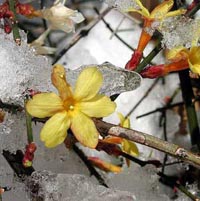Resource Library
Plant of the Week: Winter Jasmine
The University of Arkansas System Division of Agriculture does not promote, support or recommend plants featured in "Plant of the Week." Please consult your local Extension office for plants suitable for your region.
Plant of the Week
Winter Jasmine
Latin: Jasminum nudiflorum

Gardeners anticipate spring’s arrival as eagerly as a child looks forward to Christmas morning. It’s hard to wait, and so too it is with some garden plants. Already, I've spotted a clump of crocus in bloom, and the winter jasmine is starting to send forth its little yellow trumpets.
Winter jasmine (Jasminum nudiflorum) starts flowering on the first warm January day, only to be beat back by the freezes that are sure to follow. It’s the earliest shrub to bloom in the garden in our climate. Blossoms are scattered from January 'til March with peak bloom in February. The Chinese name is "Yingchunhua," or the Welcoming Spring Flower, an apt name for this early bloomer.
Winter jasmine is a little mounded plant that grows a couple feet tall with green, arching stems that cascade over walls and embankments, creating a mounded, sprawling form when allowed to grow unimpeded. It has small, lustrous, trifoliate leaves that fall with the first frost. Though deciduous, the green stems give it an evergreen appearance.
The cheery, solitary trumpets are bright yellow and about 1 and 1/2 inches long. Fully opened flowers are the size of a nickel with five or six petals. Winter jasmine never makes a single flush of flowers like forsythia, so seldom makes a show-stopping display. It belongs to the olive family, but unlike the white flowered winter jasmine and other members of the family like lilac and osmanthus, it has no fragrance.
Winter jasmine is hardy as far north as St. Louis, making it the most winter-hardy jasmine. It was introduced from China in 1844 when the English plant collector Robert Fortune sent the Royal Horticulture Society plants he had purchased from a Shanghai nursery.
Though long popular in China and an instant hit in European and American gardens when introduced in the middle years of the 19th century, today it’s considered a ho-hum shrub. Sure, it’s easy to grow but it’s just not too exciting.
I attribute this general lack of interest to the fact that there is no challenge to growing the plant and it has nothing new to offer. The plants I have observed across the country appear incredibly uniform, leading me to believe that they are all a single clone, probably just cuttings from the plant Fortune introduced 160 years ago.
It seems likely that winter jasmine is a good target for some plant breeder - either a hobbyist or professional - to perform a bit of their magic. Several related species are available in the nursery trade, so it looks like it would be a relatively easy task to develop a winter-hardy, evergreen plant with concentrated bloom set. Perhaps there is a million dollar opportunity awaiting someone with the patience to pull it off.
In the garden, winter jasmine can be grown in sun or shade, good soil or bad. It’s tough, reliable and even a bit weedy if allowed to sprawl in good soil. As the canes arch over, it roots freely, which can allow it to colonize a large area over time. Because the green stems turn brown with age, it should be cut back to shoe-top height every three or four years after the blooms finish, but before new growth begins. It has no insect or disease pests.
Winter jasmine could have a great future in modern day landscaping if designers would begin using it at the top of those stacked concrete block walls we now see at every turn. A few strategically placed shrubs would send down their arching branches and soften these massive walls. It’s also useful as a foreground planting in the shrub border to face down tall, leggy shrubs.
By: Gerald Klingaman, retired
Extension Horticulturist - Ornamentals
Extension News - February 4, 2005
The University of Arkansas System Division of Agriculture does not maintain lists of retail outlets where these plants can be purchased. Please check your local nursery or other retail outlets to ask about the availability of these plants for your growing area.